
The Rudiments of English Grammar (1761) was a popular English grammar textbook written by the 18th-century British polymath Joseph Priestley.

The Rudiments of English Grammar (1761) was a popular English grammar textbook written by the 18th-century British polymath Joseph Priestley.
While a minister for a congregation in Nantwich, Cheshire, Priestley established a local school; it was his first successful educational venture. Believing that all students should have a good grasp of English and its grammar before learning any other language, and dismayed at the quality of the instruction manuals available, Priestley wrote his own textbook: The Rudiments of English Grammar (1761). [1]
The book was very successful—it was reprinted for over fifty years. Its humor may have contributed to its popularity; for example, Priestley illustrated the couplet with this rhyme:
Priestley also quoted from the most famous English authors, encouraging the middle-class association between reading and pleasure, a reading that would also, Priestley hoped, foster morality. Priestley's innovations in the teaching and description of English grammar, particularly his efforts to dissociate it from Latin grammar, made his textbook revolutionary and have led 20th-century scholars to describe him as "one of the great grammarians of his time." [3]
Rudiments influenced all of the major British grammarians of the late 18th century: Robert Lowth, James Harris, John Horne Tooke and even the American Noah Webster. The resounding success of Priestley's book was one of the reasons that Warrington Academy offered him a teaching position in 1761. [4]

The Lunar Society of Birmingham was a British dinner club and informal learned society of prominent figures in the Midlands Enlightenment, including industrialists, natural philosophers and intellectuals, who met regularly between 1765 and 1813 in Birmingham. At first called the Lunar Circle, "Lunar Society" became the formal name by 1775. The name arose because the society would meet during the full moon, as the extra light made the journey home easier and safer in the absence of street lighting. The members cheerfully referred to themselves as "lunaticks", a contemporary spelling of lunatics. Venues included Erasmus Darwin's home in Lichfield, Matthew Boulton's home, Soho House, Bowbridge House in Derbyshire, and Great Barr Hall.

Joseph Priestley was an English chemist, natural philosopher, separatist theologian, grammarian, multi-subject educator, and liberal political theorist. He published over 150 works, and conducted experiments in several areas of science.

The Priestley Riots took place from 14 July to 17 July 1791 in Birmingham, England; the rioters' main targets were religious dissenters, most notably the politically and theologically controversial Joseph Priestley. Both local and national issues stirred the passions of the rioters, from disagreements over public library book purchases, to controversies over Dissenters' attempts to gain full civil rights and their support of the French Revolution.
In traditional grammar, a subject complement is a predicative expression that follows a copula, which complements the subject of a clause by means of characterization that completes the meaning of the subject.
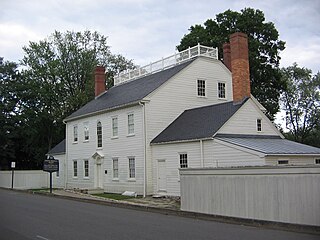
The Joseph Priestley House was the American home of eighteenth-century British theologian, Dissenting clergyman, natural philosopher, educator, and political theorist Joseph Priestley (1733–1804) from 1798 until his death. Located in Northumberland, Pennsylvania, the house, which was designed by Priestley's wife Mary, is Georgian with Federalist accents. The Pennsylvania Historical and Museum Commission (PHMC) operated it as a museum dedicated to Joseph Priestley from 1970 to August 2009, when it closed due to low visitation and budget cuts. The house reopened in October 2009, still owned by the PHMC but operated by the Friends of Joseph Priestley House (FJPH).
John Holmes was an 18th-century schoolmaster and writer on education, Master of Gresham's School in Norfolk.

Joseph Priestley was a British natural philosopher, Dissenting clergyman, political theorist, and theologian. While his achievements in all of these areas are renowned, he was also dedicated to improving education in Britain; he did this on an individual level and through his support of the Dissenting academies. His grammar textbook was innovative and highly influential. More importantly, though, Priestley introduced a liberal arts curriculum at Warrington Academy, arguing that a practical education would be more useful to students than a classical one. He was also the first to advocate the study and teaching of modern history, an interest driven by his belief that humanity was improving and could bring about Christ's Millennium.

Joseph Priestley was a British natural philosopher, political theorist, clergyman, theologian, and educator. He was one of the most influential Dissenters of the late 18th-century.

The Institutes of Natural and Revealed Religion, written by 18th-century English Dissenting minister and polymath Joseph Priestley, is a three-volume work designed for religious education published by Joseph Johnson between 1772 and 1774. Its central argument is that revelation and natural law must coincide.

Essay on a Course of Liberal Education for Civil and Active Life (1765) is an educational treatise by the 18th-century British polymath Joseph Priestley.

Lectures on History and General Policy (1788) is the published version of a set of lectures on history and government given by the 18th-century British polymath Joseph Priestley to the students of Warrington Academy.

In 1765, 18th-century British polymath Joseph Priestley published A Chart of Biography and its accompanying prose description as a supplement to his Lectures on History and General Policy. Priestley believed that the chart and A New Chart of History (1769) would allow students to "trace out distinctly the dependence of events to distribute them into such periods and divisions as shall lay the whole claim of past transactions in a just and orderly manner."

In 1769, 18th-century British polymath Joseph Priestley published A New Chart of History and its prose explanation as a supplement to his Lectures on History and General Policy. Together with his Chart of Biography (1765), which he dedicated to his friend Benjamin Franklin, Priestley believed these charts would allow students to "trace out distinctly the dependence of events to distribute them into such periods and divisions as shall lay the whole claim of past transactions in a just and orderly manner."

Essay on the First Principles of Government (1768) is an early work of modern liberal political theory by 18th-century British polymath Joseph Priestley.
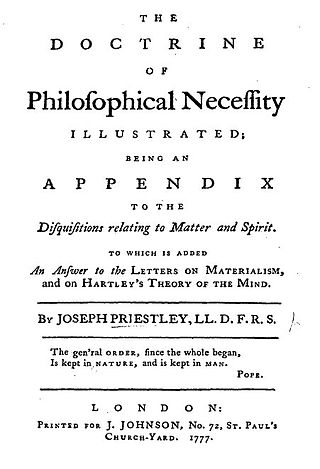
The Doctrine of Philosophical Necessity (1777) is one of the major metaphysical works of 18th-century British polymath Joseph Priestley.
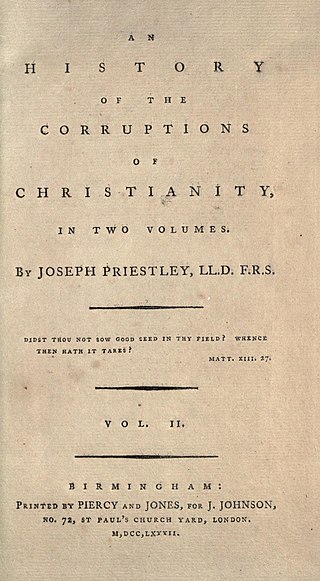
An History of the Corruptions of Christianity, published by Joseph Johnson in 1782, was the fourth part of 18th-century Dissenting minister Joseph Priestley's Institutes of Natural and Revealed Religion (1772–74).

The History and Present State of Electricity (1767), by eighteenth-century British polymath Joseph Priestley, is a survey of the study of electricity up until 1766, as well as a description of experiments by Priestley himself.
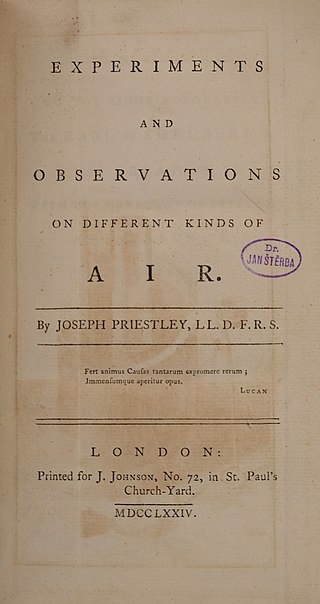
Experiments and Observations on Different Kinds of Air (1774–86) is a six-volume work published by 18th-century British polymath Joseph Priestley which reports a series of his experiments on "airs" or gases, most notably his discovery of the oxygen gas.
The history of English grammars begins late in the sixteenth century with the Pamphlet for Grammar by William Bullokar. In the early works, the structure and rules of English grammar were based on those of Latin. A more modern approach, incorporating phonology, was introduced in the nineteenth century.
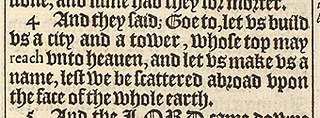
The inanimate whose refers to the use in English of the relative pronoun whose with non-personal antecedents, as in: "That's the car whose alarm keeps waking us up at night." The construction is also known as the whose inanimate, non-personal whose, and neuter whose.